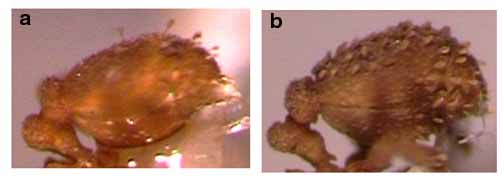
| Genus List | Species List |
The genus Rhopalothrix is a member of the monophyletic tribe Basicerotini (Bolton 1998). In their 1960 revision, Brown and Kempf wrote the following:
The species of Rhopalothrix are all apparently exceedingly rare; none of them is known away from its type locality; most are recorded from only one or two examples. Six of the known species are neotropical, from widely scattered localities ranging from Chiapas and Cuba south to Argentina. The seventh species comes from northeastern New Guinea. This distribution and the structural diversity of the seven species suggests a great age and former widespread occurrence of the genus. Little is known of the biology; the species occur in forest leaf litter or in subterranean habitats elsewhere. The collections are of strays, usually from siftings or berlesates.
Our knowledge of this genus seems to have changed little. Since the Brown and Kempf revision, individual new species have been described from Brazil (acutipilis Kempf 1962), Sri Lanka (inopinata De Andrade, in Baroni Urbani and De Andrade 1994), and Australia (orbis Taylor 1968).
No Costa Rican material has been discussed in any previous taxonomic work. I have accumulated a small amount of Costa Rican material, and recognize three species.
I assume that Rhopalothrix share the predaceous habits of other members of the tribe. The few basicerotines whose habits are known prey on small, soft-bodied arthropods (Wilson 1956, Brown and Kempf 1960, Wilson and Brown 1985).
10a. Gastral dorsum with at most one pair of spatulate setae a little over half way back, and a cluster near the apex; labrum deeply notched with lateral lobes rounded: 100
10b. Gastral dorsum evenly covered with conspicuous spatulate setae; labrum with a small median notch, lateral lobes shallowly bilobed: JTL-001


100a. Side of head above antennal insertions with three subequal gibbosities, nearly aligned, giving the head a subquadrate aspect: JTL-004
100b. Side of head with only median gibbosity projecting (where the transverse ridge attains the side of the head), giving a subtriangular aspect: weberi

Literature Cited
Baroni Urbani, C., De Andrade, M. L. 1994. First description of fossil Dacetini ants with a critical analysis of the current classification of the tribe (Amber Collection Stuttgart: Hymenoptera, Formicidae. VI: Dacetini). Stuttg. Beitr. Naturkd. Ser. B (Geol. Palaontol.) 198:1-65.
Bolton, B. 1998. Monophyly of the dacetonine tribe-group and its component tribes (Hymenoptera: Formicidae). Bulletin of the Natural History Museum London (Entomology) 67:65-78.
Brown, W. L., Jr., Kempf, W. W. 1960. A world revision of the ant tribe Basicerotini. Stud. Entomol. (n.s.) 3:161-250.
Kempf, W. W. 1962. Miscellaneous studies on neotropical ants. II. (Hymenoptera, Formicidae). Stud. Entomol. 5:1-38.
Taylor, R. W. 1968. Notes on the Indo-Australian basicerotine ants (Hymenoptera: Formicidae). Aust. J. Zool. 16:333-348.
Wilson, E. O. 1956. Feeding behavior in the ant Rhopalothrix biroi Szabo. Psyche (Camb.) 63:21-23.
Wilson, E. O., Brown, W. L., Jr. 1985 ("1984"). Behavior of the cryptobiotic predaceous ant Eurhopalothrix heliscata, n. sp. (Hymenoptera: Formicidae: Basicerotini). Insectes Soc. 31:408-428.
Page author:
John T. Longino, The Evergreen State College, Olympia WA 98505 USA.longinoj@evergreen.edu